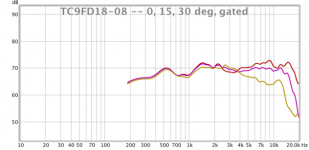That's why I've posted polar data. Response on listening axis is important but the response off axis is equally important.
It is my understanding that most measuring software these days uses the swept sine technique which calculates an impulse response from a sine sweep recording. Magnitude and phase is calculated from that impulse response.
The expensive professional packages use stochastically applied series of impulse step functions rather than swept sine. Swept sine is fine but ultimately is secondary derived as the fundamental data is the amplitude vs time response.
It's like measuring frequency with a frequency meter vs looking at the time resolved trace on an oscilloscope or transient digitizer. The transient digitizer with a fast mic will tell you the actual slew rate of a speaker in its ability to force pressure in time. A pleated AMT tweeter will be superior here but may measure identically or similar to conventional tweeter. They will sound very different when asked to reproduce a fast transient like a plucked string.
Can you post the Impulse response at 0deg, 15deg, 30deg, 45deg? I can't extract that a polar contour plot as you present. Looks nice but to me, appears to not be smooth and have lots of peaks and dips.
You've got PM. Please let us know what you find.
The expensive professional packages use stochastically applied series of impulse step functions rather than swept sine. Swept sine is fine but ultimately is secondary derived as the fundamental data is the amplitude vs time response.
It's like measuring frequency with a frequency meter vs looking at the time resolved trace on an oscilloscope or transient digitizer. The transient digitizer with a fast mic will tell you the actual slew rate of a speaker in its ability to force pressure in time. A pleated AMT tweeter will be superior here but may measure identically or similar to conventional tweeter. They will sound very different when asked to reproduce a fast transient like a plucked string.
So are you saying that the swept sine technique used by software like ARTA, REW or similar is incapable of producing impulse responses that are an actual representation of how the device under test actually behaves?
So are you saying that the swept sine technique used by software like ARTA, REW or similar is incapable of producing impulse responses that are an actual representation of how the device under test actually behaves?
No, not at all - the swept sine technique works very well and is great for majority of measurements. I believe it can't provide as high a resolution of the driver's inherent transient response. I use REW and Holmimpulse and happy to do so for free. I know that my measurements don't show a difference in the crispness of transients when I look at the derived IR, but I hear the difference between a cone driver and an AMT driver.
I'm sure its fascinating stuff but I dont quite know whats happened to this thread. Not that I'm pointing fingers as it went relatively off subject long ago.
No, not at all - the swept sine technique works very well and is great for majority of measurements. I believe it can't provide as high a resolution of the driver's inherent transient response.
That is an interesting question although I doubt the swept sine technique is the limiting factor as it can obtain results with much higher resolution than what humans can perceive.
I use REW and Holmimpulse and happy to do so for free. I know that my measurements don't show a difference in the crispness of transients when I look at the derived IR, but I hear the difference between a cone driver and an AMT driver.
Did you rule out that the perceived differences aren't caused by much simpler effects like amplitude response differences on-axis and off-axis?
You've got PM. Please let us know what you find.
Pnix,
Thanks for the measurements, can you tell us what conditions were the measurements for the A7.3 were made? Drive voltage, distance of mic, type of enclosure, gating time, etc. In any event, the measurements look like they were carefully made and have gating applied to reduce room effects. I distilled your measurements down to 3 angles 0 deg, 15 deg, and 30 deg to keep the amount of data small for comparison with one of my favorite drivers, the Vifa TC9FD.
Here is a summary view of the three different measurements at 0, 15, 30 deg for both drivers. Clearly, the A7.3 has a much higher extended frequency response than the TC9FD, but it is not as smooth. There is a large dip at about 1.7kHz and a rather large cone breakup feature starting at about 9kHz with two large breakup peaks at 10.4kHz and 13.5kHz:

Here is the Impulse Response for the A7.3 at 0 deg, note the large amount of hash/ringing that occurs after the initial pulse - this will sound like an audible background after-effect on sharp percussive sounds that would otherwise sound clean and results from the inverse Fourier transform of a non-smooth frequency response. What shows up in frequency, must show up in the time domain and vice versa. Most notably, there is a ringing oscillation at about 10kHz that will have a sibillant effect:
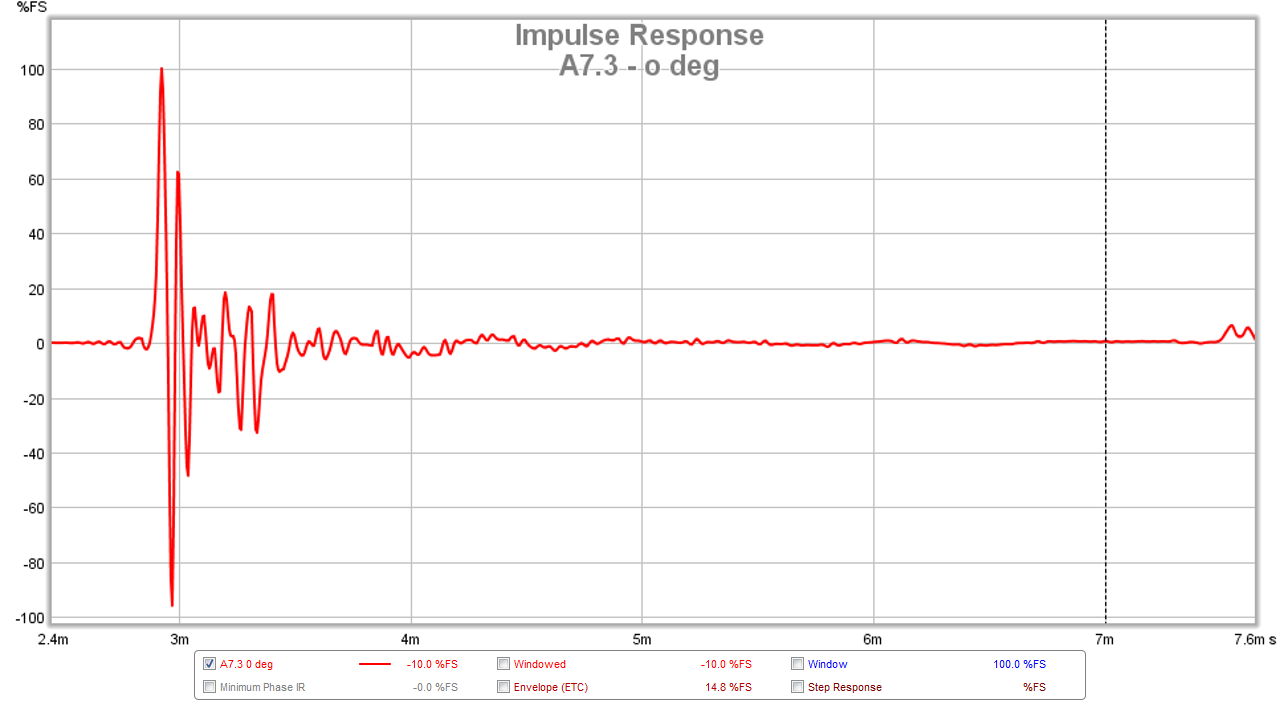
Here is the Impulse Response for the A7.3 at 15 deg, it starts to noticeably appear cleaner with less hash/ringing after the initial pulse. It may be the sweet spot for listening with the A7.3:
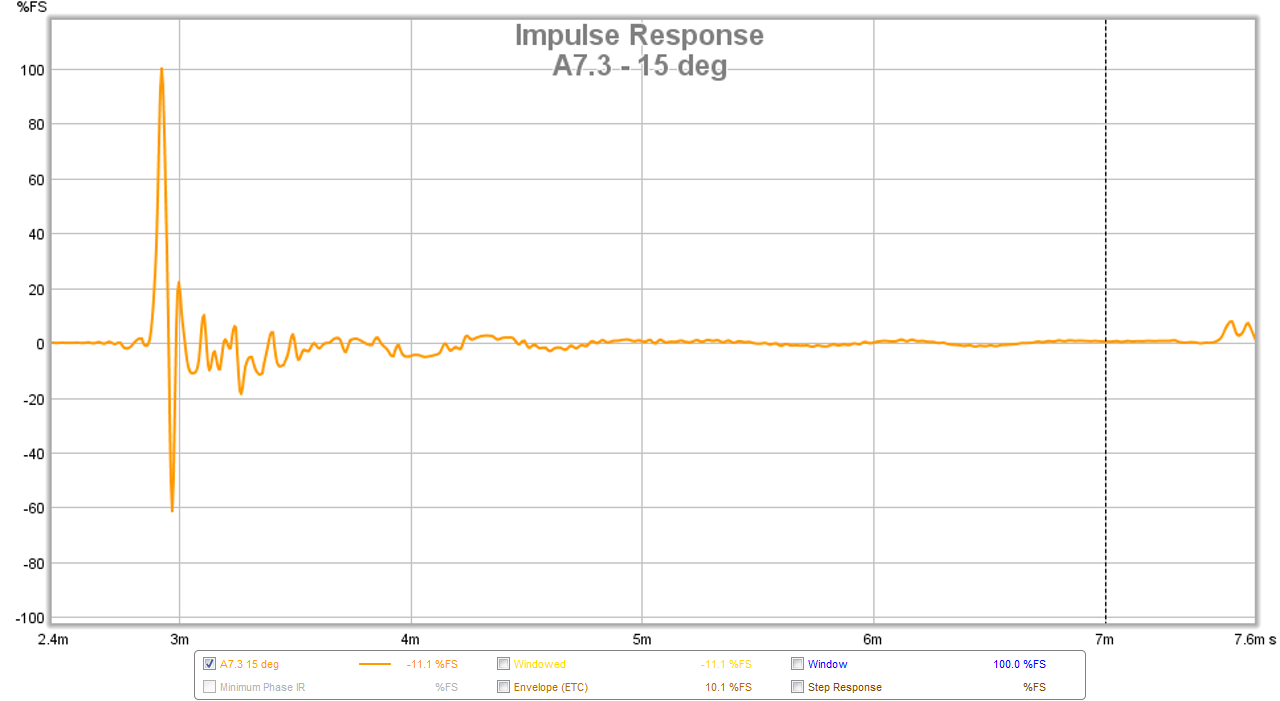
Here is the Impulse Response for the A7.3 at 30 deg, here there is some more after-pulse content showing up again and would lead to audible near-field echo like sound:
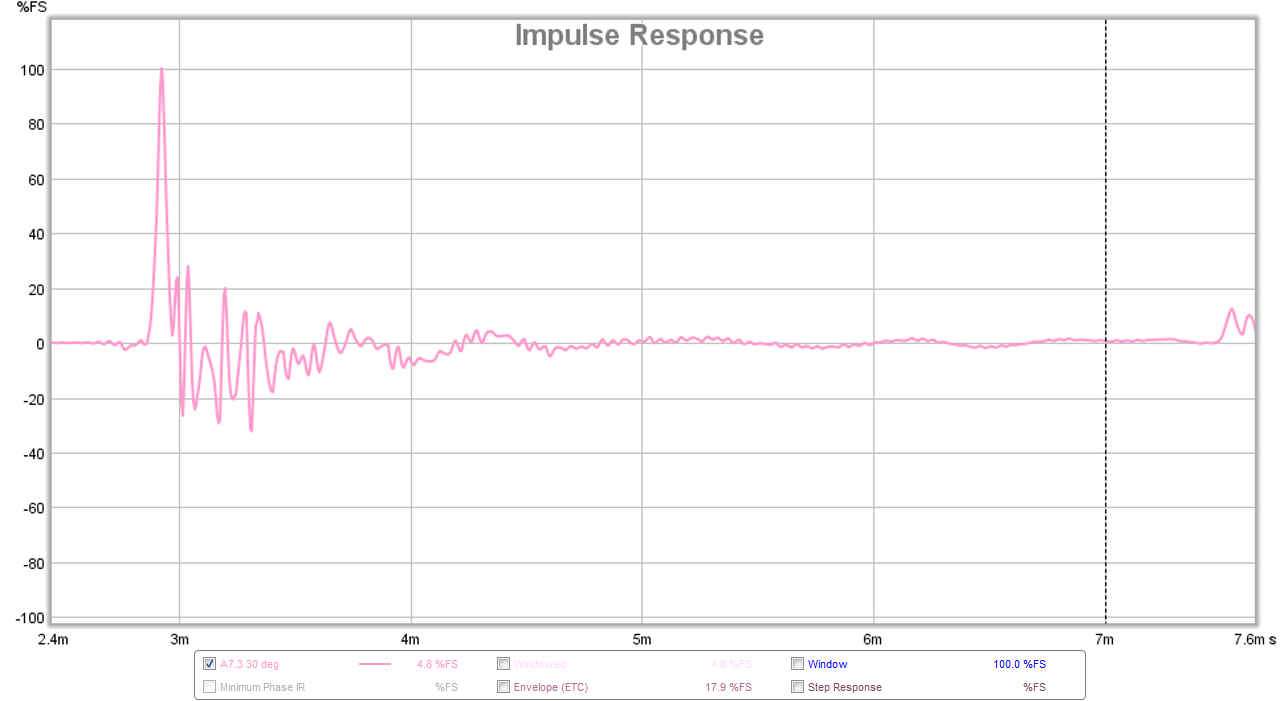
By comparison, here are the Impulse Responses for the TC9FD at the same three angles as measured on a Nautaloss sealed tapered TL. The pulses are cleaner with a main pulse and a single major overshoot pulse followed by low levels of noise.
TC9FD at 0 deg:
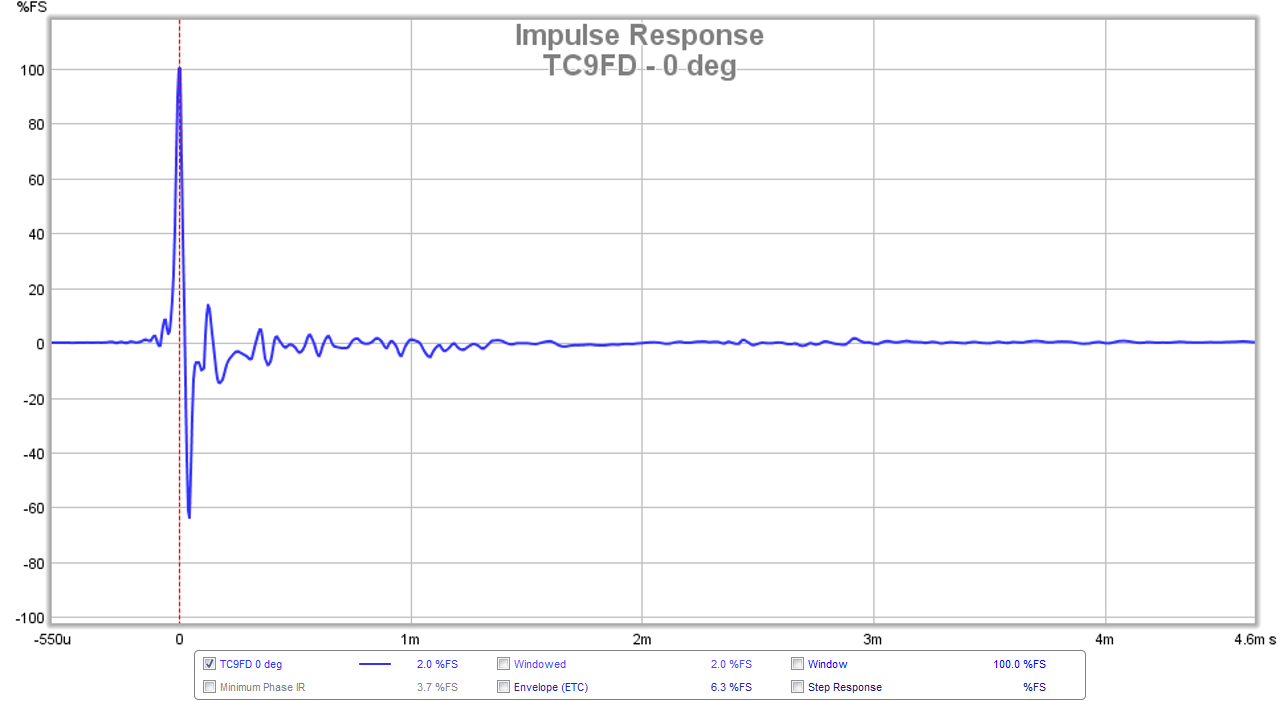
TC9FD at 15 deg
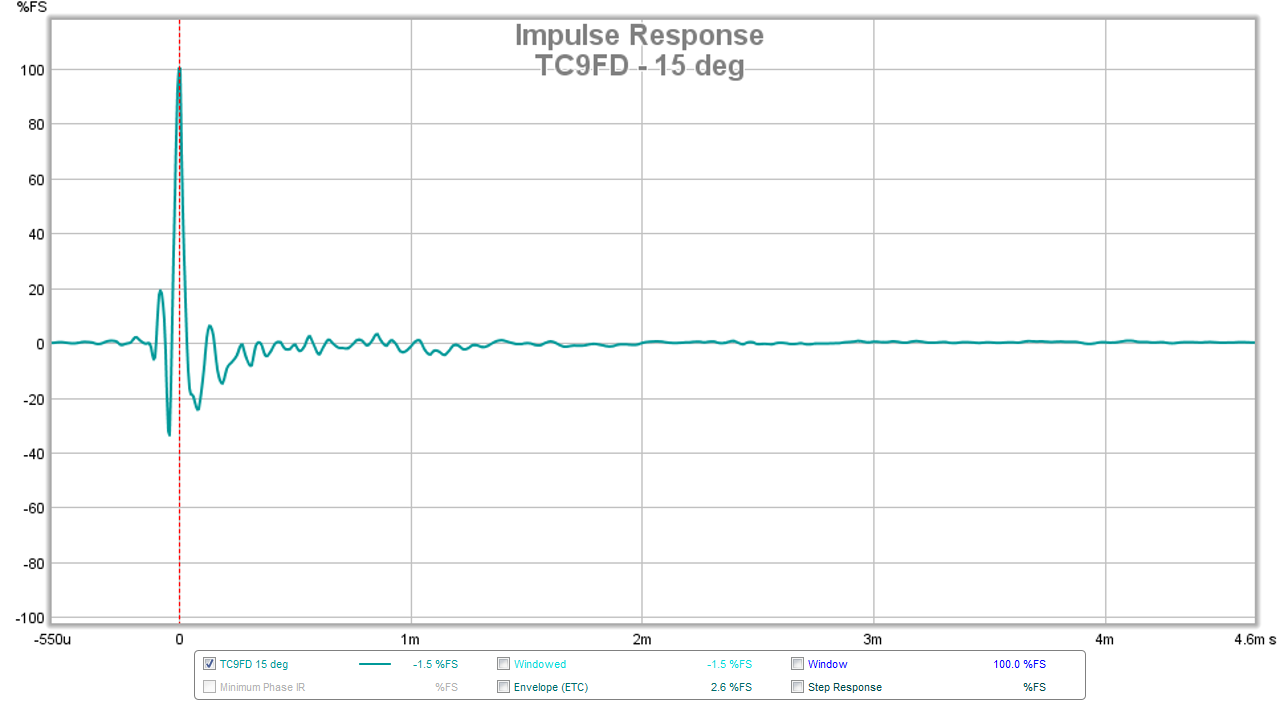
TC9FD at 30 deg:
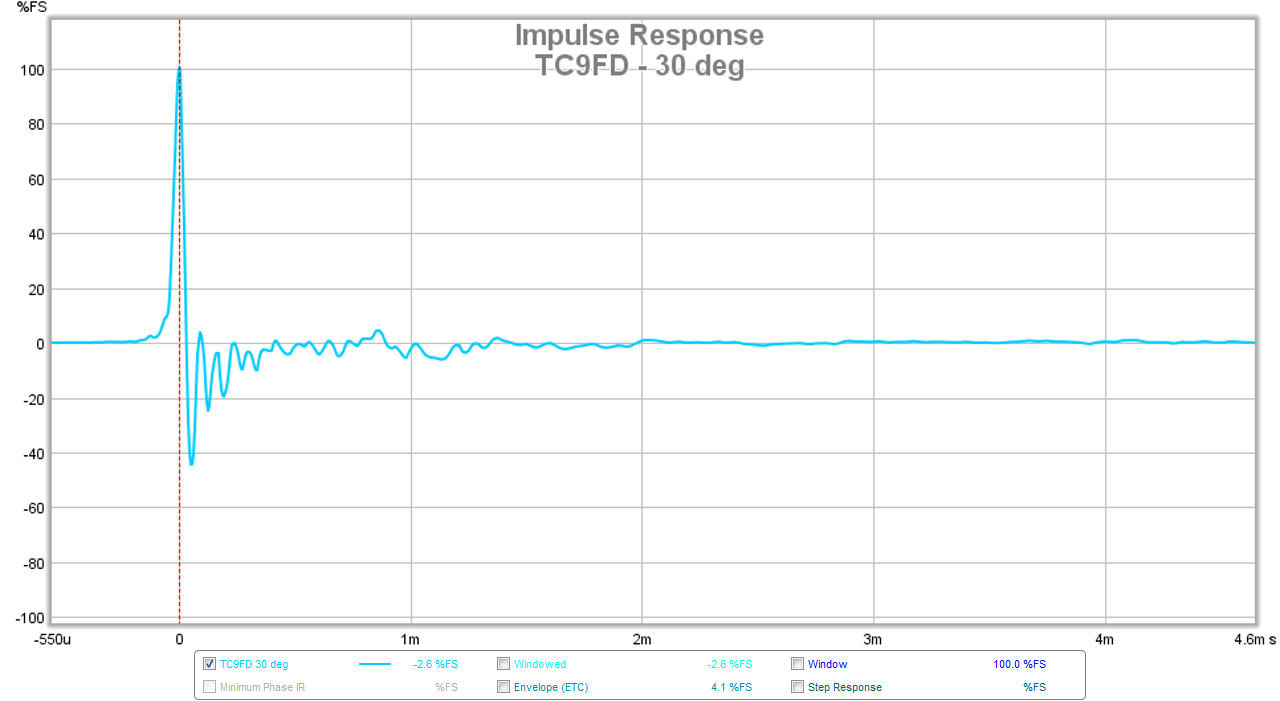
Here is the measured minimum phase variation for the A7.3:
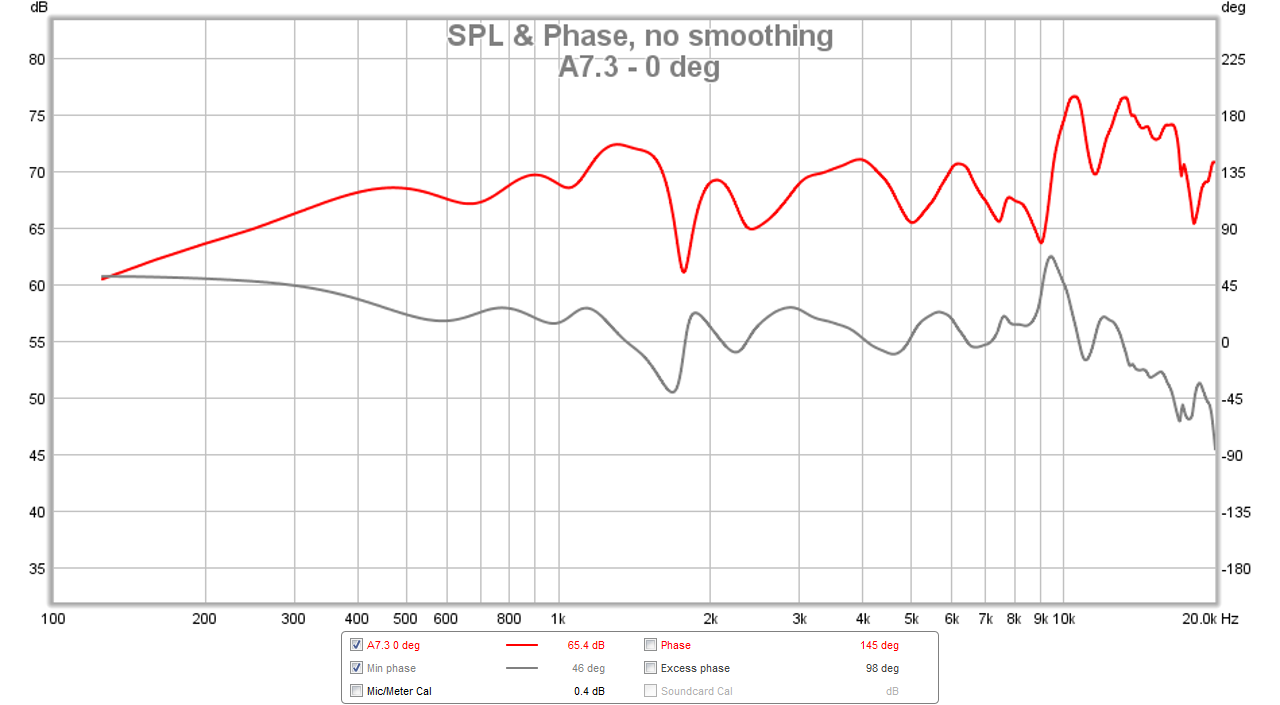
Minimum phase for TC9FD:
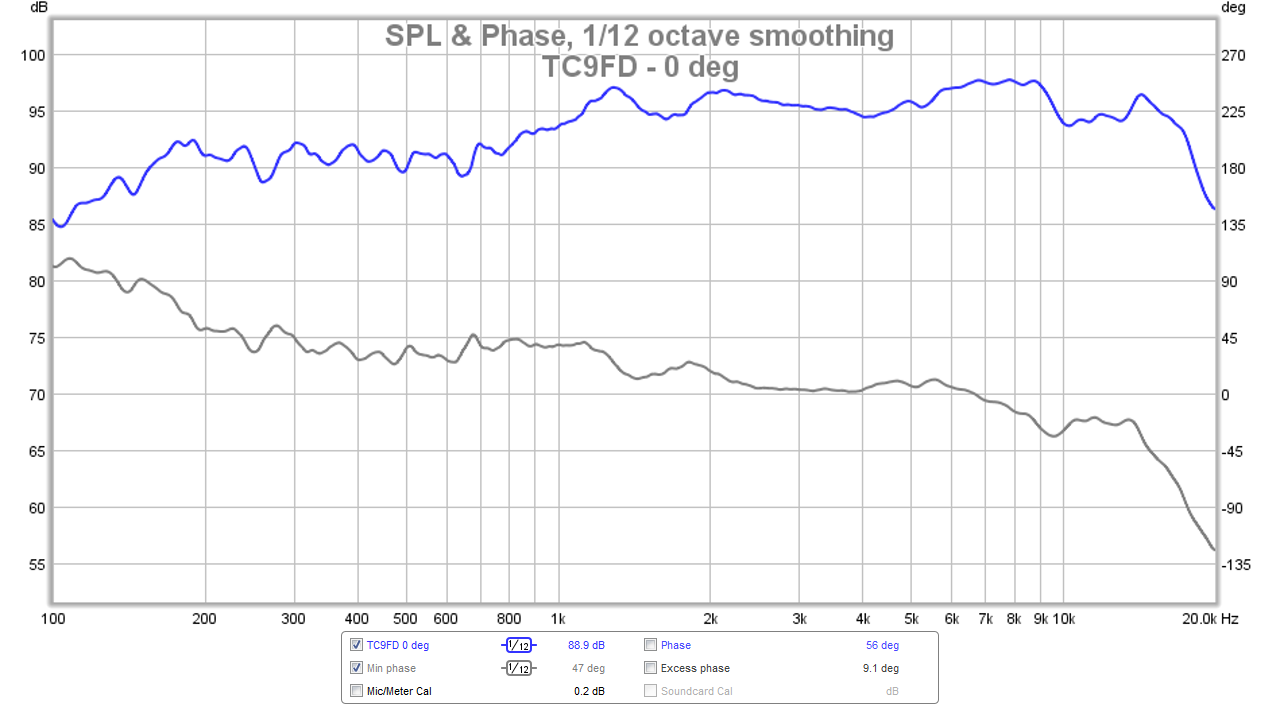
The dips and peaks can also affect the imaging coherency of the driver through phase variations that stray from a flat response.
I think a lot of this has to do with the difference between an aluminum cone and a paper cone. Also, I think that to achieve an extended HF response, the A7.3 is relying on lots of cone breakup to generate the higher frequencies that the pistonic action of the cone cannot provide. It's a tradeoff that has worked because a lot of people seem to like the HF airyness at the expense of articulate replication of sharp percussive sounds.
Attachments
-
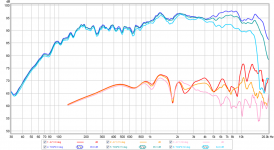 a7.3-vs-tc9fd-freq-response-all.png164.1 KB · Views: 1,211
a7.3-vs-tc9fd-freq-response-all.png164.1 KB · Views: 1,211 -
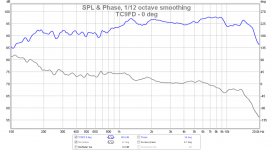 tc9fd-min-phase-0-deg.png97.9 KB · Views: 399
tc9fd-min-phase-0-deg.png97.9 KB · Views: 399 -
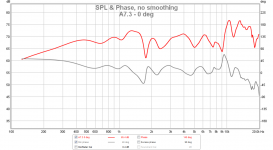 a7.3-min-phase-0-deg.png100.1 KB · Views: 388
a7.3-min-phase-0-deg.png100.1 KB · Views: 388 -
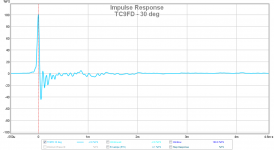 tc9fd-ir-30-deg.png67 KB · Views: 407
tc9fd-ir-30-deg.png67 KB · Views: 407 -
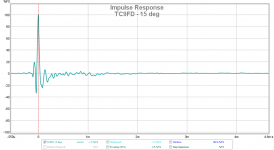 tc9fd-ir-15-deg.png70 KB · Views: 405
tc9fd-ir-15-deg.png70 KB · Views: 405 -
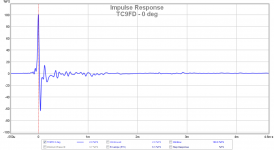 tc9fd-ir-0-deg.png66.2 KB · Views: 785
tc9fd-ir-0-deg.png66.2 KB · Views: 785 -
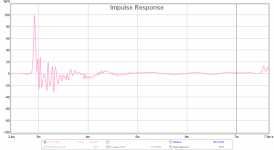 a7.3-ir-30-deg.png72 KB · Views: 396
a7.3-ir-30-deg.png72 KB · Views: 396 -
 a7.3-ir-15-deg.png72.5 KB · Views: 562
a7.3-ir-15-deg.png72.5 KB · Views: 562 -
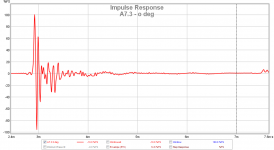 a7.3-ir-0-deg.png79 KB · Views: 1,609
a7.3-ir-0-deg.png79 KB · Views: 1,609
Last edited:
What does the Impulse Response sound like?
REW lets you export the Impulse Response as a .wav file which I have attached below. The wav files are packed in zip files each containing the response at the three angles (0, 15, 30 deg) for each driver. Any audio player should be able to play a wave file - put it on repeat and use headphones to listen.
Listen to the Impulse tracks and you can hear the type of "temporal" coloration that an aluminum cone introduces vs a smooth paper cone, Listen to the TC9FD at 0 deg and you will get an idea of a clean impulse (sounds much a like a sharp clap sound with very little post clap coloration).
For the cases where you hear near field echoing or a "halo" effect, that is the ringing and sibillance. Imagine this after-effect of the initial clap sound superimposed on all the transients that are part of music that we listen to.
REW lets you export the Impulse Response as a .wav file which I have attached below. The wav files are packed in zip files each containing the response at the three angles (0, 15, 30 deg) for each driver. Any audio player should be able to play a wave file - put it on repeat and use headphones to listen.
Listen to the Impulse tracks and you can hear the type of "temporal" coloration that an aluminum cone introduces vs a smooth paper cone, Listen to the TC9FD at 0 deg and you will get an idea of a clean impulse (sounds much a like a sharp clap sound with very little post clap coloration).
For the cases where you hear near field echoing or a "halo" effect, that is the ringing and sibillance. Imagine this after-effect of the initial clap sound superimposed on all the transients that are part of music that we listen to.
Attachments
imo, both drivers is showing unacceptable FR.
when you can hear 3db difference, I dont see how its justifiable to have a driver that has +-7db difference across the spectrum
then add the effect of a untreated room and real disaster could happen where one user could have in his living room +-20db difference with a flat speaker: imagine what a unflat fullrange based speaker can do.
I dont wonder why you see some folks building dozens of fullrange based speakers. how can you ever be satisfied on the long run where even the best full range drivers show terrible response over 5khz? the only barely acceptable solution is to cross a fullrange at 4-5khz to a tweeter. but even then, they all show 5db rise from 1khz to 5khz.
when you can hear 3db difference, I dont see how its justifiable to have a driver that has +-7db difference across the spectrum
then add the effect of a untreated room and real disaster could happen where one user could have in his living room +-20db difference with a flat speaker: imagine what a unflat fullrange based speaker can do.
I dont wonder why you see some folks building dozens of fullrange based speakers. how can you ever be satisfied on the long run where even the best full range drivers show terrible response over 5khz? the only barely acceptable solution is to cross a fullrange at 4-5khz to a tweeter. but even then, they all show 5db rise from 1khz to 5khz.
Last edited:
but even then, they all show 5db rise from 1khz to 5khz.
That is baffle step, which is normally corrected with a coil/resistor BSC, or with EQ. This effect is also present on multi-way speakers and is handled as part of shelving filter in XO. So that is not something inherent in full range drivers.
can you please show me the measurments of a well setup fullrange based system that is able to correct those issues with BSC that result in flat FR from at least 150hz to 5khz?
EQ is not a option. it messes with phase and adds all sort of problem.
your speaker must be flat to begin with.
and then use small EQ like 2-3db.
Eq ing a speaker just to make it flat with 5 db shelves is unnacceptable, no?
EQ is not a option. it messes with phase and adds all sort of problem.
your speaker must be flat to begin with.
and then use small EQ like 2-3db.
Eq ing a speaker just to make it flat with 5 db shelves is unnacceptable, no?
Last edited:
can you please show me the measurments of a well setup fullrange based system that is able to correct those issues with BSC that result in flat FR from at least 150hz to 5khz?
EQ is not a option. it messes with phase and adds all sort of problem.
your speaker must be flat to begin with.
and then use small EQ like 2-3db.
Eq ing a speaker just to make it flat with 5 db shelves is unnacceptable, no?
Mild broad (low Q) Eq cuts (vs boost) if done well has little detrimental effects to phase. 5dB cuts to HF shelf is done all the time in most speakers full range or not. Certain speakers like BIB's BLH, TQWT's have substantial bass gain from their horns that BSC is not needed. When I have time I will dig up some plots. What speaker or driver do you have that is natively flat? You won't find many drivers flatter than the TC9FD.
EQ is not a option. it messes with phase and adds all sort of problem.
your speaker must be flat to begin with.
and then use small EQ like 2-3db.
Eq ing a speaker just to make it flat with 5 db shelves is unnacceptable, no?
There is no such thing as a flat wide-band driver. There are some drivers that are remarkably smooth like the little Tymphany ones but that's still far from being audibly flat.
If the response is minimum phase then EQ will fix the phase response too. This might sound counterintuitive but that's how amplitude and phase are linked within a minimum phase system.
... one of my favorite drivers, the Vifa TC9FD. ...

The TC9FD seems to be a winner. I just happened to measure one lately. Good to see that both our measurements match nicely. Looks like amateurs like us can produce good data without the need for an anechoic chamber or professional measuring software and microphones!
Attachments
Last edited:
REW lets you export the Impulse Response as a .wav file which I have attached below. The wav files are packed in zip files each containing the response at the three angles (0, 15, 30 deg) for each driver. Any audio player should be able to play a wave file - put it on repeat and use headphones to listen.
Listen to the Impulse tracks and you can hear the type of "temporal" coloration that an aluminum cone introduces vs a smooth paper cone, Listen to the TC9FD at 0 deg and you will get an idea of a clean impulse (sounds much a like a sharp clap sound with very little post clap coloration).
For the cases where you hear near field echoing or a "halo" effect, that is the ringing and sibillance. Imagine this after-effect of the initial clap sound superimposed on all the transients that are part of music that we listen to.
Those impulse responses include the whole room in which the driver was measured so this is not a fair comparison.
Those impulse responses include the whole room in which the driver was measured so this is not a fair comparison.
True, room effects are present but room won't make a driver ring like a bell at 10kHz which is what you mostly hear as that is 20% to 60% amplitude of primary pulse.
I dont wonder why you see some folks building dozens of fullrange based speakers. how can you ever be satisfied on the long run where even the best full range drivers show terrible response over 5khz?
Good for wide-band driver manufacturers isn't it 🙂
the only barely acceptable solution is to cross a fullrange at 4-5khz to a tweeter. but even then, they all show 5db rise from 1khz to 5khz.
This will cause tweeter bloom. Dispersion of the full range driver is narrow while the tweeter has a broad dispersion. Reflections will be spectrally distorted.
In my opinion wide-band drivers have a right to exist if high directivity and value are of high priority. This rules out small full range drivers and anything above a certain price range.
hi pnix - - which existing drivers lay in this sweet spot of acceptable diameter and value vs a reasonable multiway approach? how does it matter in the multiway how tweeter directivity at xover and beyond is managed? which tweeters if any, are appropriate as "helpers" to maintain a good blend of directivity to the wideband? Inductor and capacitor prices can be reasonable if not "boutique" but still add up. What can and can't be easily fixed?
adding a tweeter is a very complicated thing and you need to have experience if you want perfectly in time and in phase with both drivers.
hi pnix - - which existing drivers lay in this sweet spot of acceptable diameter and value vs a reasonable multiway approach? how does it matter in the multiway how tweeter directivity at xover and beyond is managed? which tweeters if any, are appropriate as "helpers" to maintain a good blend of directivity to the wideband? Inductor and capacitor prices can be reasonable if not "boutique" but still add up. What can and can't be easily fixed?
In my opinion it doesn't makes sense to pair any tweeter with a wide-band driver. It makes more sense to pair a smallish wide-band driver with a capable woofer to reduce distortion at the low end.
Other than that larger full-range drivers make sense if the goal is to obtain narrow directivity with less complexity than a multi-way design.
Regarding passive crossovers, they are a waste of time. Buy a cheap miniDSP. Building two different crossovers takes hours, doing the same in DSP takes seconds.
- Status
- Not open for further replies.
- Home
- Loudspeakers
- Full Range
- Why bother with FRs?
